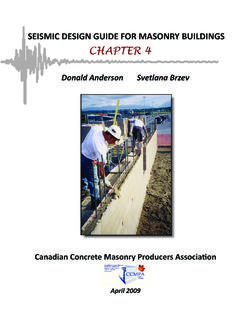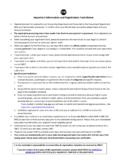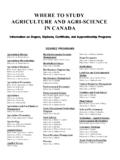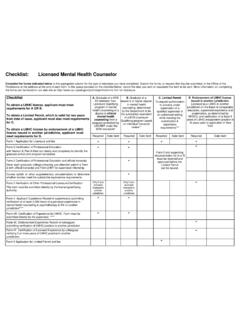Transcription of Firewalls - CCMPA
1 W w w . c c m p a . c a5A-0 FirewallsBy Gary Sturgeon, , MSc., Services Engineer, CCMPAw w w . c c m p a . c a5A-1 FirewallsThis Chapter of the CCMPA Metric Technical Manual has been largely reproduced from Firewalls , A Design Guide , published by the Canadian Concrete and Ma-sonry Codes Council (CCMCC) in 1992. It also includes updates for consistency with NBCC-10, and additional material synthesized from other related What is a firewall ?A firewall is the ultimate defense against the spread of fire. It must be able to withstand the onslaught of a fire and prevent further fire spread by containing it to one side of the wall until the fire burns itself out, or is most stringent provisions in our Building Codes with regard to structural stability and fire performance apply to Firewalls . Firewalls must be suitably designed and constructed to function as a barrier against the spread of fire and smoke.
2 They are subject to very specific requirements regarding use, fire-resistance rating, structural stability, and construction. Requirements for Firewalls are not typical of any other fire separation. The NBCC-10 definition for firewall states that it must have the structural stability to remain intact under fire conditions for the required fire-rated time . If a fire were to occur on one side of a firewall , collapse of the building or of a portion of the building on the fire-exposed side of the firewall must not cause the firewall to collapse or otherwise fail within the code-required, fire-rated time assigned to that firewall . This need for structural integrity during the fire event is an im-portant distinction between the Building Code requirements for a firewall and for a fire separation. Because of this important distinction, design options and recommendations for compli-ance with the structural stability requirements for Firewalls are discussed in the Structural Considerations section of this chapter.
3 The term firewall is often used when referring to a fire separa-tion. This is incorrect. As noted in Chapter 5 of this Manual, a fire separation is typically a wall or floor assembly that acts as a barrier to the spread of smoke and fire, yet it may or may not be required to have a fire-resistance rating, although most do have some inherent fire-resistance. A required fire-resistance rating for a fire separation may be achieved through the use of combustible or noncombustible building materials, provided combustible construction is permitted for the building by the Building Code. A fire separation need not satisfy requirements for structural integrity. These are not the case for a to the design of Firewalls intended to comply with Part 3 of NBCC-10, code references include the following: a. requirements pertaining to determining fire-resistance ratings are stated in Subsection , and Appendix D, Division B, Fire Performance Ratings ;b.
4 Requirements for closures are provided in Subsection ;c. requirements for service penetrations are given in Sub-section ;d. requirements pertaining to firewall connections and their relationship to structural collapse, required fire-resistance ratings, firewall continuity, and projection beyond combus-tible construction are contained in Subsection ;e. requirements related to their structural design are provid-ed in Article and in Commentary C , Structural Integrity of Firewalls in the User s Guide NBC 2010, Structural Commentaries (Part 4 of Division B) .Requirements specific to Firewalls under Part 9 of the NBCC are contained in Subsection Notably, by Article , where Firewalls are used they are to be con-structed in accordance with the requirements of Part the 2005 edition of the NBCC, all Firewalls regardless of the required fire-resistance rating were required to be constructed of concrete or masonry.
5 The 2005 edition of the NBCC permitted Firewalls having a fire-resistance rating of not more than 2 hrs. to be constructed of other than concrete or masonry. This requirement remains unchanged in the 2010 edition. Discussions pertaining to this requirement, the use of alternative firewall construction, and the associated inherent risks of using other than concrete or masonry firewall construc-tion are provided in Section of this 5 Fire Performance , offers the groundwork for an understanding of fire performance issues, provides discussion fully relevant to Firewalls , and complements the information specific to Firewalls provided in this chapter. The reader is therefore urged to review the material presented in Chapter Application of Firewalls A firewall is designed and constructed with the primary purpose of dividing a building into separate entities or building areas, which are considered as separate build-ings under the NBCC for the purposes of fire protection.
6 The wall acts as a barrier against the spread of fire from one area to another to prevent major conflagration, total w w w . c c m p a . c a5A-2 Firewallsor partial loss of the building of fire origin, total or partial loss of adjacent buildings, and injury to occupants of the building of origin and to occupants beyond. In accordance with the assigned and stated Objectives of Part 2, Division A , NBCC-10, and the assigned and stated Functional Statements of Part 3, Division A, a firewall is intended to: limit damage to the building of origin due to fire, explosion, or collapse of physical elements or struc-tural insufficiency, or loss of use due to structural insufficiency; limit damage to adjacent buildings, or otherwise be-yond the building of origin caused by fire, explosion or collapse of physical elements; and, limit exposure of building occupants, and occupants in adjacent buildings to injury due to fire, explosion, structural insufficiency or collapse of physical firewall satisfies these objectives by: retarding the effects of fire beyond its point of origin; limiting or accommodating expected loads and forces.
7 Retarding its own failure or collapse due to the ef-fects of fire or explosion; and, resisting deterioration expected from service Separation of BuildingsThe division or separation of buildings by a firewall can be utilized in a number of situations. Where a wall is jointly owned and used by two parties sharing a build-ing and is erected at or upon a property line, it is called a party wall. Since, in effect, it divides a single build-ing extending across a property line into two buildings, it must be constructed as a firewall (Article , NBCC-10).The use of a firewall in a building under one ownership on a single property can be beneficial. The two areas of a building created by a dividing firewall are each con-sidered by the NBCC as separate areas (Figure ) (Article , Division A, NBCC-10). The fire protec-tion requirements of the NBCC are then applied to each separate area rather than to the building as a whole.
8 Such requirements typically become less stringent with a decrease in building area. Therefore, it is usually more economical to apply the fire protection requirements of each smaller portion of the building than those of the building as a whole. Installation of several Firewalls at appropriate intervals will permit a structure to contain a total area many times the maximum permitted for a single building area. Height and area limitations based on the occupancy, type of construction and fire fighter access govern the number of Firewalls required within a given building. Figure : Example firewall Separation of Major OccupanciesA firewall can also be used for the separation of major occupancies (Figure ) (Article , NBCC-10). Although most different major occupancies can share the same building, a high hazard occupancy (Group F, Division 1) is not permitted in the same building as an assembly, institutional or residential occupancy (Groups A, B, or C) (Article , NBCC-10).
9 Figure : NBCC Minimum firewall RatingsNote: Group F-1 occupancies are not permitted within the same building as Group A, B or C occupanies (Article , NBCC-10).w w w . c c m p a . c Additions and RenovationsA firewall can also be useful when adding to, or rehabilitating an existing building. A proposed addition may increase a building s area so that more stringent fire protection requirements must then be applied to the entire building, not only to the addition. Placing a firewall at a well-chosen location divides the old and new construction into separate buildings. Thus, the existing building would not require upgrading to the current Building Code. The addition may also then be permitted to comply with less stringent fire protection requirements than would the total buildings constructed years ago do not, and cannot, comply with fire protection requirements of today s Building Code because of their construction type.
10 If, because of renovation, such a building would be required to be upgraded to comply with the current Building Code, the use of a firewall to create two smaller buildings that meet current fire protection requirements may be the Business Loss ReductionsMany factories and warehouses enclose large areas used for hazardous processes and storage of products. In such buildings, Firewalls are the ideal type of fire separation for use in limiting the amount of materials that may be exposed in a fire. Dividing a building into truly isolated fire compartments that will confine a fire to its place of origin and prevent its spread is the most important means of reducing the over-all fire risk in a building. Limiting fire spread will limit the loss of sup-plies, machinery, and records. Delays incurred in replac-ing a destroyed building can result in a permanent loss of customers.







